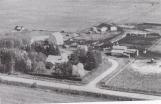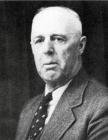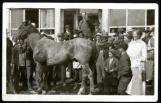7
Aerial view of Bentley and the Damron farm.Early 1900's
Rural Bentley Alberta
 Credits:
Credits:Bentley Museum Society
8
CLARENCE F. DAMRONC. F. Damron came to Bentley in 1902. On September 17, 1909 he had his first auction sale, $1700 worth of farm machinery and livestock for Clyde Everenden, an early pioneer of the Bentley district. That was the beginning of over fifty years of working as an auctioneer in this area. He was the best-known auctioneer of the west and the dean of the province's auctioneering ranks. His name and slogan, "knows values and gets them", became synonymous with selling. Hundreds of persons throughout the province knew him by one of four names - C.F., Pete, Clarence and Kimball.
The name Kimball came from his hunting days. Firing into a flock of partridge without mussing a feather caused one of his partners, taking his cue from the name of a famous marksman of the era, to holler, "nice shot, Kimball."
Clarence had been in the cattle business since 1886. That was the year he started working as a messenger boy between the Union Stockyards and the offices of Sir Thomas Lipton's Packing Company in Omaha where he was born. The work of the messenger wasn't to this boys liking, he needed more action. Soon he started selling sandwiches and popcorn balls (made by his mother) to the traders and buyers after school and on Saturdays. It wasn't long and he was buying crippled animals from the Commission men and selling them back to the packing plants. By the time he was fourteen he was a full-fledged trader in the Union Stockyards, buying and selling feeders on his own. It seems he was never out of the cattle business. He raised purebred Herefords for thirty years.
As a young lad working at the stockyards in Omaha he had plenty of time to listen and learn the techniques of auctioneering. Working on his father's farm he practiced selling a team of horses over and over again.
In the early homestead years he sometimes drove his team of horses up to forty miles to do a sale. When the sale was over, he always drove back home again.
One time he did one sale which ended at 7:30 p.m. and he had to be at his next sale eighty miles away at 10:00 the next morning. It took three teams to do the trip. The temperature was thirty below.
Another time he drove from Bentley to Bullocksville, forty-three miles away. It was thirty five below at noon and forty eight below when he got back to Lacombe.
Then there was the time in 1920, it took him about sixteen hours, and three teams to travel a total distance of thirteen miles. A Chinook had softened the snow, which was about three feet deep, and the horses were up to their bellies.
During his auctioneering years he set a hectic pace. In his first year he had twenty-eight sales. By 1918 he had one hundred and twenty-eight sales in one year, forty-two of them coming on forty consecutive days, not counting Sundays. On two days he had sales in the morning and afternoon.
Mr. Damron had two farm sale bills framed, one when the auctioned items totaled $26,400 and one auction that brought in $138. (the high and low.)
On January 2, 1907, they opened the Damron Brothers meat market. Steak sold at three pounds for a quarter, and liver was given away when requested. A front quarter of beef sold for three cents a pound and a hind quarter for four cents a pound. They also had a meat route to Gull Lake. They made the trip every day to supply the holiday-makers with meat and peddling goods around the country side put the meat market on a paying basis.
In 1924, C. F. Damron helped organize the Lacombe Farmers Horse Sale. Some of the sales held there were the largest of that type in Canada, and possibly in the world - a sale of farmer's horses, intended for draft work. C. F. sold the first horse at the sale in 1924 and the last one in 1950.
One of the largest sales was in March 1939. It was a three day sale. There were 1,036 horses listed. They sold for a grand total of $82,091.50. The top horse brought $200.00 and the top team $480.00. Thirteen stallions were the last to sell for a total of $2,940.00.
Norva Landry remembers this large horse sale as she and a friend skipped school one of the three days and took in the horse sale. They hitchhiked there and back. The next day at school their teacher asked them all the questions from the work covered the previous day. He had always encouraged his students to get out and see more of their surroundings, but I guess a horse sale wasn't what he meant.
The highest price Damron ever got for work horses was $815.00 for a team of Belgian mares. He had sold cows for more. One time in 1948 he sold twenty eight cows for a total of $40,000.00. In the CPR dispersal sale in 1943, one bull sold for $5,000.00. That was a lot of money in 1943!
C.F.'s advice for anyone having a farm auction was to make sure it is very well advertised. Also it is important to have the goods well organized. Machinery should be in good repair and well painted. Lunch should be served. People feel very different when they have had a good lunch and hot coffee.
Clarence F. Damron is the man who brought the cash auction to Western Canada. Terms of those first sales: All sums of ten dollars or under, cash: over that amount, credit of nine months given on joint notes at eight percent interest. A cash discount of five percent given on all sums over ten dollars.
One time in 1943, Damron said he bought nine carloads of stocker cows at a cost of $15.40 each. He fed them all winter and sold them in the spring for 2 ľ cents a pound. He never made a cent on the deal. He said however, that other transactions went better for him.
As C.F. worked as an auctioneer, he saw horses come in and go out as tractors replaced them. He saw the land broken and the Town of Bentley grow. He said the beautiful Blindman Valley would always be a part of him. Clarence Damron, served on many local boards and was very active in community affairs.
Besides auctioneering Mr. Damron had a passion for fishing. He spent a considerable amount of time in his later years at Buck Lake. He spent many winter days making plugs of every size and shape. These plugs lured the big ones to his fishing line. Damron's other hobbies were refinishing antiques, helping his wife look after their large garden and playing checkers with his wife.
Confessions of An Auctioneer
Family Herald - July 2, 1959 by Ina Bruns
"Painting machinery to keep it in condition is a good thing," said C.F. Damron, "but when I drive onto a farmyard to conduct a sale and find out-of-date equipment sporting a gaudy camouflage over the rust of years, my heart sinks into my boots. About the only one who gets fooled is the artist. He usually doesn't get paid for his efforts."
At his opening sale, another auctioneer said derisively: "He's a small wind that will soon blow over!" "The small wind" has gone on and on with a hurricane force that has scattered people's possessions over the map in a way that would shame a Missouri Tornado!
Farm and livestock auctioneering calls for the voice of a lion, the eye of an eagle and a cast-iron constitution - C.F. Damron had them all.
"We get to know human nature pretty well in this business," Damron said," and we know when a man cheats in the game, but it is usually better for the auctioneer to take the blame for error."
Damron believed that the sale ring should never be a launching platform for the grubby story or uncouth remark. He always thought a little innocent joking helps warm up the crowd, but you can't hike bids by throwing out dirt or insults.
______________________________________________
9
The Tale of the Terrible Damron BullListen, kind friends and listen well,
To the terrible tale that I have to tell
Of the Damron bull who went astray
To a life of crime that didnít pay.
It happened the spring of "43"
That a Hereford bull, that old A. E.
Had trucked to town for the annual sale
Seemed to think he was goiní to jail.
And, no sooner from the truck did land,
That he jerked the rope from the truckerís hand,
He bellered and bawled, and pawed the sod-
A real old Ferdinand on the prod.
And he said to Damron, "Good bye pal,
Iím feeliní tough, and Iím on the prowl.
Yes, Bud, Iím a-leaviní you far behind,
And Iím goiní to see what I can find."
So he ran Ďtil he came to the river Bow,
Where he jumped right out on a big ice floe.
And he floated downstream for a little while
ĎTil he came right to St. Georgeís Isle.
Yes friends, itís strange, but itís true,
That bull ended up in the Calgary Zoo.
The keeper looked out, and he said, "My God,
Thereís a great big bull and heís on the prod."
Then Leo the Lion, began to roar,
And the monkeys howled and cussed and swore.
The bears and the tigers and the kangaroo,
And all the animals in the zoo.
They all got mad, yes, they were really full
Of rage, when they sighted the Damron bull.
Then the keeper got mad and he said, "All right,
Iíll turn you loose, and Iíll let you fight."
So, he opened the door of every cage,
And all of the animals full of rage,
They all rushed out, and they charged pell mell
At the Damron bull, Yes, he sure caught hell.
But ere the setting of the sun
The bull had killed them, every one,
And he bellered and bawled, and pawed the sand,
The fightenest critter in all the land.
Well, the news of the battle quickly spread
And the people were filled with fear and dread.
Yes, they all were filled with fear that night
And they closed all their doors, and locked them tight.
When the policemen heard of the terrible tale
They locked themselves in the city jail.
They left their whiskey, and they left their beer,
The Stampede City was full of fear!
When Damron heard what his bull had done,
He grabbed his rope and grabbed his gun.
He was plenty mad and he started to swear,
And he throwed his saddle on his old grey mare.
And Iím telliní you folks, Iím a-telliní you true,
He rode right out there to the zoo.
And he found his bull still fightiní mad.
He dropped his gun, and he said "By Gad,
Iíll fight you bull and Iíll fight you fair,
Iíll fight you right here, or anywhere."
Then he grabbed that bull right by the horn.
And folks, as sure as you wuz born
That bull went down right on his side
And Damron quickly jumped astride
And sank his teeth in the old bullís throat
And soon the island was afloat
With the blood of the terrible Damron bull
And Damron drank till his belly was full.
St. Georgeís island was red with blood,
And so indeed was fearless Bud.
Then he dragged that bull out into the stream,
And jumped aboard, as in a dream.
They floated away in the pale moonlight
And theyíve never been seen, since that terrible fight.
Some say that they drifted right down to hell.
Letís hope it was heaven, BUT YOU NEVER CAN TELL!
From "Rollicking Rhymes" by C.L. Connelly - 1964





